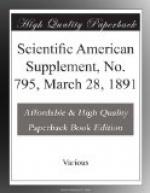Sig.—Teaspoonful three or more times during twenty-four hours.
However, toward the end of the fourth week, especially in one case—a stout, heavy-set gentleman—very grave asthmatic symptoms developed, which compelled me to apply Chapman’s spinal ice bag, as well as resort to the internal administration of large doses of codeine during the paroxysm, with the most beneficial result.
I gave also oxygen inhalations a fair trial in the two cases. I find them to act very soothingly in the simple asthma, facilitating respiration after a few minutes; but during the paroxysmal stage they cannot be utilized, for the reason that respiration is short and rapid, and does not permit of a control in the quantity of the gas to be inhaled. Consequently, it is either of little use as a remedy; or, if too much is taken, a disagreeable headache will be the consequence.
During the catarrhal stage, which, however, was very mild compared with last year, I derived great benefit from the administration of codeine, in combination with terpine hydrate, in the pill form. The codeine has the advantage over all other opium preparations that it does not affect the digestive organs, and still acts in a soothing manner. While during last year’s sickness my patients lost from ten to twenty pounds of their bodily weight, this year but one lost eight pounds and the other five pounds.
As the etiology of this troublesome disease is yet enveloped in obscurity, we may fairly conclude, by the success of my treatment, if it should meet with the confirmation of the profession, that the much pretended sensitive area, situated, according to Dr. Sajous, “at the posterior end of the inferior turbinated bones and the corresponding portion of the septum,” or, according to Dr. John Mackenzie, who locates this area “at the anterior extremity of the inferior turbinated bone,” need not necessarily be removed or destroyed by cautery, in order to accomplish a cure of hay fever proper.
I examined my patients twice a week, and the closest rhinoscopical exploration would not reveal the slightest pathological change in the mucous membrane of the nares.
Now, what is the etiological factor of the disease? Is it a specific germ conveyed by the air to the parts and—locus minoris resistencia—deposited at the pretended area, or is the germinal matter present in the nasal mucous membrane with certain persons, and requires only at a certain time and under certain conditions physiological stimulation to manifest periodical pathological changes, which give rise to the train of symptoms called hay fever? Dropping all hypothetical reasoning, I think some outside vegetable germ is causing the disease in those predisposed, and peroxide of hydrogen acts on them as it does on the pus corpuscles, i.e., drives them out when and wherever it finds them. I hope the profession will give this new measure a thorough trial and report their results.—Therapeutic Gazette.




